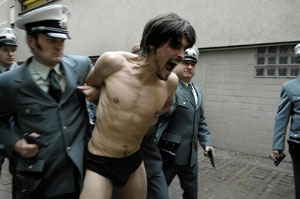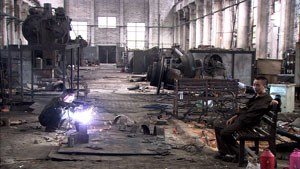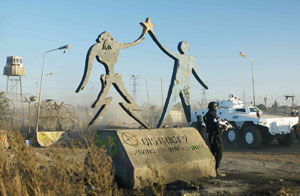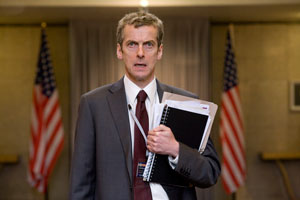LASHINGS OF THE OLD ULTRA-VIOLENCE
 Wednesday, November 2, 2011 at 09:23PM
Wednesday, November 2, 2011 at 09:23PM The Baader Meinhof Complex, Dir: Uli Edel; Surveillance, Dir: Jennifer Lynch
The Baader Meinhof gang—as the press called them - did not play around. In the early 1970s, the Red Army Faction—the name they preferred— set off bombs in US Army barracks, German newspaper offices and various police headquarters. They trained in Palestinian guerilla camps, robbed German banks, gunned down district attorneys and kidnapped police chiefs. Our pyschosis features a sexual/political agenda. © Constantin Film Produktion
Our pyschosis features a sexual/political agenda. © Constantin Film Produktion
The RAF did not lack for hubris or competence as they helped to invent modern day terrorism. According to this dramatization of the eponymous non-fiction book, they could bomb, shoot, kidnap and speechify. But they sucked at avoiding arrest.
And so the second half of their grand political drama played out in German prisons and courtrooms. Led by whining complainer journalist/social theorist Ulrike Meinhof (while on the lam she would not stay anywhere without central heating and kept telling the Palestinians what uncomfortable shitholes their desert training camps were) and charismatic sociopath Andreas Baader, the RAF made a mockery of the German justice system –an easy target, granted. While imprisoned, they gained increasing control over their day to day lives to the point that their colleagues smuggled in pistols and ammunition. Meinhof hung herself after four years in jail, much of it spent in solitary and the rest in the forced company of Baader’s main squeeze, Gudrun Ensslin. Apparently Gudrun—something of a sociopath —made Meinhof’s life inside an utter hell.
After members of the RAF had been incarcerated for five years, Palestinian-trained terrorists hijacked a German commercial flight with the specific purpose of ransoming out the RAFers and terrorists held in other countries. When the hijacking failed, and the hijackers were shot down on a runway in Mogadishu, theRAFers died in their cells. The film suggests the two with guns shot themselves and the others followed Meinhof’s example….shortly after, a kidnapped German industrialist was murdered by the new cells of the RAF in revenge.
It’s quite a saga, and director Uli Edel captures all aspects of the gang: their charisma, the romance of their struggle, their sex appeal (apparently the women robbed banks with Uzis and leapt over teller counters in mini-skirts, peasant crop-tops and lace-up knee-high white boots). Not to mention their at one time good intentions, the repressive German police apparatus which they so despised and the state-sponsored violence against protestors. With equal emphasis, Edel depicts the horrific bloody consequences of the RAF’s actions and the internal blood-letting without which no revolutionary cell would be complete.
Gudrun held Meinhof in such contempt that while they were training at a desert camp, Gudrun gave Al Fatah the secret code word that Meinhof’s fugitive children and nanny would assume came only from Meinhof. Al Fatah made it clear to Gudrun that if they picked up the kids - who were safe somewhere in Europe - they would be whisked into Palestinian camps and thier mother would never see them again. Without consulting Meinhof, Gudrun gave the go-ahead.
Edel walks the narrowest of tightropes and never falters. He shows the broader political actions that triggered the gang’s rage and the internal logic of their arguments, yet never once fails to also show the dismembered bodies of their victims. Or the profound sexual kicks the gang got from its violence. Edel takes no moral or political position. He’s a historian. It's brave a film, a film so willing and even more surprising, able, to embrace such a narrative with the complexity it warrants.
He takes a while to do it, too. Complex is over two hours long, and every sequence seems necessary. The opening is a bravura urban spectacle. Iranian pro-Shah apparatchiks assault anti-Shah protestors on the streets of Berlin, and, with the cops’ passive approval, beat the living shit of out of them. In a moment evokingPotemkin’s Odessa Steps, the German mounted police charge down the cobbled streets into Edel’s deliriously tracking camera, smashing the heads of fleeing students. A right-wing goon squad executes a student in the plain view of the cops. They do nothing. This is presented as the seminal radicalizing event for the RAF.The brutal thrills of this sequence evoke Edel’s model: Costa-Gavras’ Z and State of Siege, two of the most visually dynamic political histories and political thrillers ever made.
 Ours omits the politics.
Ours omits the politics.Once the leaders get thrown into jail, the pace slows. The RAF argues with each other in their cells and the judge in court. Baader had better instincts for political theatre than politics, and he turned the courtroom into his stage. Newbie cells sprang up around Germany, and their younger more hardassed members easily equaled the RAF founders for viciousness. Baader plaintively tells one cop: “These new groups operating in our name are so much more violent than we ever were.”
Surveillance
Jennifer Lynch, the writer/director of Surveillance, takes a much more American view of sociopathic violence; her protagonists kill and maim because, in a modern America of alienation, crippling boredom and dysfunctional relationships, it gets them off when nothing else will.
This forms a rather old-fashioned view of the cathartic killing off of squares by a hip elite. It springs from the heyday of arty low budget violent exploitation, the American International Pictures and their imitators of the early and mid 1970s.
Bill Pullman appears to have aged poorly. He looks like a drunk Irish cop. Julia Ormond was once briefly the next big thing and here reclaims her career by turning an exploitation caricature into an icon of sophisticated sex appeal and depth. Lynch’s last film— ten years back —was the abomination Boxing Helena, which showcased her dad’s disdain for narrative and her own inability to convincingly create atmosphere. Here, there actually is a plot. Serial killers terrorize the countryside; Bill and Julia play the FBI agents brought in to bring them down.
They arrive in psychotic American nowheresville, where the local cops shoot out the tires of passing tourists, so they can sexually humiliate and rob them. Again, just for kicks and pocket change – harmless fun. The traffic stop scenes prove as harrowing as the explicit serial killer violence and get as close to a theme as Lynch embraces: America makes people crazy. And what do crazy people like the best? They like to make other people crazy.
The traffic stop cops, who see themselves as morally superior to the serial killers, are presented as only the first falling domino in the collapse of society. They and the serial kiiller are not ying and yang, but only points on a continuum. How old-school hipster is that?
The tiny cast are unknown but recognizable character and stage actors. They relish their hinky roles and only occasionally drift into self-parody. The dialogue offers plenty of Lynchian quirk and some really unsettling subconscious character reveals. Lynch toys with the idea that the killers are the sanest folks in town, if only because they are the least in denial. But she chucks that notion overboard for an orgasmic bloodletting finale both truly disturbing and creepily hot. Very AIP.
This would be a smart genre picture if this genre still existed. Now it’s an anomaly: a self-conscious, amusing, far from perfect but still compelling journey into unease, madness and blood. And all, it turns out, in the service of letting true love thrive.
 Baader Meinhof,
Baader Meinhof,  Bill Pullman,
Bill Pullman,  Julia Ormond,
Julia Ormond,  State of Seige,
State of Seige,  Surveillance,
Surveillance,  Z
Z 





